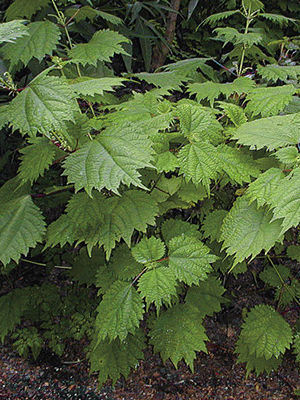1. Sycamore-Leaved False Nettle

Name: Boehmeria platanifolia
USDA hardiness zones: 5 to 8
Size: 3 to 5 feet tall and 3 to 4 feet wide
Conditions: Full sun to partial shade; moist, well-drained soil
Its common name might be a mouthful, but sycamore-leaved false nettle is a plant worth telling a friend about. Though it resembles a sycamore (Platanus spp. and cvs., Zones 3–8), this perennial has 5-inch-wide leaves that look more like serrated green clamshells arranged symmetrically up its stems, each connected by a red petiole. Subtle but beautiful, this easy-care plant promises to add drama to any shade garden. Thin sprays of white flowers—a textural contrast—appear in late summer through fall. Though it prefers even moisture, this nettle can also take moderately dry shade.
2. Rhubarb

Name: Rheum rhabarbarum and cvs.
Zones: 3 to 8
Size: 2 to 3 feet tall (3 to 5 feet in bloom) and 3 to 4 feet wide
Conditions: Full sun to partial shade; average soil
It’s easy in pies and easy on the eyes. For bold texture, edible rhubarb excels. Unlike most plants with leaves that look tropical, rhubarb eschews the heat of southerly climes in favor of the chilly Northeast. This plant wakes up early and grows quickly in the cool at the start of the growing season, and tends to decline as heat sets in. Plant it in partial shade to keep it going as a foliar accent through summer. Removing spent leaves in midsummer can prompt a new flush of foliage for fall. And remember, if you’re eating rhubarb, its leaves are toxic, so be sure to remove them first from its edible stalks.
3. Giant Coneflower

Name: Rudbeckia maxima
Zones: 4 to 8
Size: 5 to 7 feet tall and 3 feet wide
Conditions: Full sun; average to dry, well-drained soil
You’re probably familiar with plain ol’ black-eyed Susan (Rudbeckia fulgida and cvs., Zones 4–9), but what about a Susan with cool flowers and pretty leaves, too? True to its name, giant coneflower sends up skyrockets of golden flowers up to 7 feet tall in late summer, but this easy-care sun lover proves showy long before that, with paddles of steely blue foliage throughout the growing season. It’s a prairie dweller, and it needs full sun or it gets floppy; given that and well-drained soil, it’s happy.
4. ‘Sea Heart’ Brunnera

Name: Brunnera macrophylla ‘Sea Heart’
Zones: 4 to 8
Size: 6 to 12 inches tall and 1 to 2 feet wide
Conditions: Partial to full shade; moist to dry, well-drained soil
‘Sea Heart’ is a billowing brunnera for shade, with gilt silver leaves shaped like stylized hearts. It’s similar to its cousin ‘Jack Frost’, but it has sturdier foliage, is more tolerant of humidity and heat, and makes a glittering addition to the dry-shade garden. Like others of its clan, ‘Sea Heart’ is a spring bloomer—a show-off with sprays of delicate blue—but this cultivar begins blooming one to two weeks earlier, which translates to a longer period of interest overall.
Andrew Keys is a lifelong gardener and the author of Growing the Northeast Garden. He lives north of Boston, Massachusetts.
Photos: #1, Joshua McCullough; #2, Nancy J. Ondra; #3, Michelle Gervais; #4, courtesy of Plants Nouveau


















Comments
Log in or create an account to post a comment.
Sign up Log in